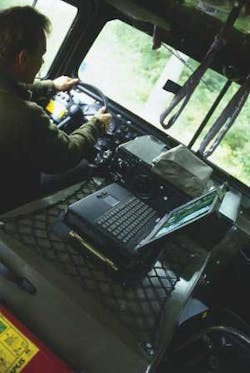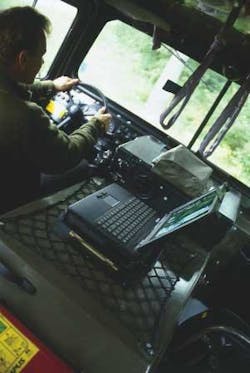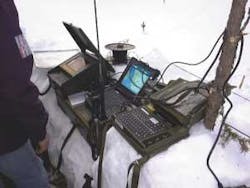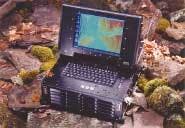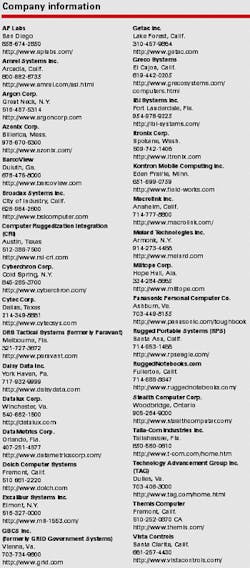Wealth of choices for tough computers that meet exacting requirements are one example of how the commercial off-the-shelf market is maturing far beyond the narrow old spectrum of COTS-vs.-mil-spec.
By John Keller
Hardware options for defense and aerospace electronics systems integrators who need rugged mobile computers are perhaps broader than ever, with a wide variety of tough computers available in configurations ranging from standard notebooks to vehicular- and rack-mount models.
While variety has always been a hallmark of the rugged computer business, however, manufacturers have taken pains recently to develop models that very closely meet the specific needs of many system integrators where ruggedness, size and weight, price, and configurability are concerned. In fact, today's offerings of rugged mobile computers represent their own testimonial in how commercial off-the-shelf (COTS) procurement is supposed to work.
null
Eight years ago, when then-Defense Secretary William Perry first institutionalized COTS as a design and procurement philosophy, options were limited where it came to rugged mobile computers, as well as to many other kinds of electronic hardware and software. Choices often reflected the central debate of the day — custom-designed and application-specific military and aerospace equipment, or purely commercial office-grade equipment; very few offerings were available to bridge the gap between the two.
Today that is all changed. If a systems designer or computer user wants a standard off-the-shelf notebook computer able to withstand the shock and vibration of vehicular use but that does not have to operate in environmental extremes of torrential rains, heat, and humidity, then products are available from several reputable vendors. Yet if an integrator needs portable rugged computers that he can configure with third-party circuit boards, he can easily find what he needs. Then again, if the integrator needs extremely tough rack- or vehicle-mount computers that users can wash down with soap and water, take multiple 3-foot drops, and withstand the kinds of ballistic shocks associated with combat, then these machines are available, too — and often at less cost than the custom-designed computers of 10 years ago.
One solid example of the latest standard ruggedized notebooks available is the Rocky Patriot I from Amrel Systems Inc. of Arcadia, Calif. This machine has an Intel Pentium microprocessor, high-capacity hard drive, and options for wireless use. Although the Patriot I is not designed to withstand ballistic shock, it meets ruggedization standards of MIL STD 461D as well as 810D, yet offers some of the latest computer components.
Rugged notebooks
"Compare it to the more fully rugged machines, and you will find that ours usually has a faster CPU speed, and high levels of memory," says Linda Talcott, director of marketing at Amrel. With the full-military or fully rugged units, the concentration is on ruggedization, and some lag a little bit on higher performance. Our competitors tend to have larger-sized machines, and their weight is heavier than ours."
Computers in the Amrel Rocky family resist rain, and have fault-tolerant isolation chambers that keep the computer's motherboard separate from connector parts in case of water leakage or incursion of dust or sand, Talcott explains. The machines also have removable hard drives and swappable components such as CD ROM drives, she says.
Other members of the Amrel Rocky family include the Patriot II in-vehicle computing station, the Patriot III combination laptop and in-vehicle computing station, and soon will include a rugged tablet computer, Talcott says.
Computer tablets, in essence, are large handheld devices with screens about the size of notebooks. These devices are relatively thin and light, have touch-screens, accept and recognize handwriting, and often have the benefits of full-blown Widows operating systems. These devices sometimes offer docking systems to work with keyboards, large desktop screens, as well as external hard disks and CD-ROMs.
Users of Rocky computers include military forces in The Netherlands, Denmark, Norway, Belgium, and Germany, who use the machines for air-to-ground targeting with the F-16 jet fighter-bomber.
Also in this class of rugged notebook computers is the A-Series from Getac Inc. of Lake Forest, Calif. Originally designed for military use, the A-Series has a magnesium-alloy chassis, is sealed from the environment with O-ring gaskets, and is cooled with heat-pipe technology. The machine has an Intel Pentium III microprocessor, meets MIL-STD 810F, an optional transflective liquid crystal display screen, and an optional two-bay expansion slot and hot-swap battery.
Other rugged Getac offerings include the W-120 ruggedized mini-notebook computer, the CA25 wireless rugged tablet PC, and the ruggedized tablet computer.
"We are noted for heavy-duty construction. All our units use heavier metal, and the aerospace-type heat pipe design for getting heat out of the notebook," explains Joe Chernof, government account manager at Getac. The company's rugged computers meet MIL-STD-810F for shock and vibration, and can operate to temperatures as cold as -20 degrees Celsius without screen heaters, he says.
One of the company's largest rugged computer customers is a systems integrator in Canada, which Chernof will not name, that markets Getac computers under its own name, he says. Other customers of Getac computers include the Union Pacific Railroad, which uses them to control systems in the cabs of locomotives, where the machines are subject to shock, vibration, dust, and dirt, but not to heavy rain, Chernof explains.
Getac also offers rugged tablet computers in 5- and 10-pound versions. "Tablets are not selling like crazy yet, but with them you are not dragging around a keyboard," Chernof points out. "They have not reached their full potential because conventional customers in the military are slow to accept a new product," and because the tablet market has yet to mature like the notebook computer market.
Another provider of rugged notebook computers is Itronix Corp. of Spokane, Wash., which specializes in rugged notebooks, handheld personal digital assistants (PDAs), and handheld PCs. Itronix is working with Trident Systems Inc. of Fairfax, Va., as well as with representatives of the U.S. Army 82nd Airborne and 10th Mountain divisions to develop a situational awareness system for infantry soldiers, says Matt Gerber, vice president of marketing at Itronix.
"We are leveraging the SINCGARS radio system for a data application for the footsoldier," Gerber says. "We are building capabilities for SINCGARS to transmit coordinates of equipment, men, and enemy positions back to command posts for running up the chain of command."
The centerpiece of this system will be the Itronix H-206 handheld PC, which meets MIL-STD 810F, and operates in temperatures between 0 and 40 Celsius. "The person in the field will have the H-206," Gerber says. "Rather than radioing his position back, he would click on icons on the screen of the computer to indicate enemy positions, and drag onto the display what is out there currently. That information goes back to the command bunker and up the chain of command."
Itronix classifies its computers as:
- commodity for indoor office use;
- semi-rugged for mobile indoor use;
- rugged for in-vehicle use; and
- ultra-rugged for demanding outdoor applications.
At the core of the Itronix strategy is to offer rugged computers "that fit in most categories," Gerber explains. This is a common trait among rugged computer manufacturers to meet customer requirements in price, capability, and reliability.
At Kontron Mobile Computing Inc. of Eden Prairie, Minn., officials are trying to cover every niche of their customer base with offerings ranging from rugged vehicle-mount computers, to rugged notebooks, rugged handhelds, and even rugged tablet PCs.
"We have shock and vibration-dampening material throughout our products, tuned to frequencies such as tanks, aircraft, or carts rolling over the tarmac," says Kontron President Dale Szymborski. "We are remote locations, or in the rain, or in the intense sunlight."
Rugged mobile computers from Kontron are mission loaders and downloaders for the Global Hawk unmanned aerial vehicle, are part of the U.S. Army Force XXI Battle Command Battalion/Brigade and Below project, as well as for monitoring and patrol personnel in Bosnia. "Daylight readability is extremely important to us," Szymborski says. We have two different technologies to allow users to see it outside. We have a transflective-panel color TFT, which is similar to color PDAs. Transflective allows backlighting and some light reflectivity. The brighter it is outside, the brighter the display gets."
Kontron computers are ruggedized for shock, vibration, electromagnetic interference, and water resistance, but cut costs by using sealed connectors, rather than mil-spec connectors, Szymborski says.
Providing rugged computers without using costly custom or mil-spec components also is a strategy at Panasonic Computer Solutions Co. in Secaucus, N.J. Panasonic officials created what they call a paradigm shift in 1996 when they introduced the CF-25 rugged computer. "Before that, rugged computers were heavy, very expensive, and weighed 15 or 20 pounds," says Panasonic spokesman Jeff Ayers. "Panasonic came to law enforcement with the CF-25, which was similar in form factor to the notebooks of the day, it had a Pentium microprocessor, and came in at around four-thousand bucks."
Today, Panasonic continues to follow up on that initial computer offering with the fully rugged Panasonic Toughbook 28 notebook, and the semi-rugged Toughbook 72. Company officials recommend the Toughbook 28 for outdoor activities that may involve rain, and the Toughbook 72 for mobile applications that are primarily indoors where shock and vibration are issues, but where substantial moisture is not involved. Panasonic also offers the Toughbook 34 rugged notebook and the semi-rugged Toughbook 48. The Toughbook 28 costs about $4,000, while the Toughbook 72 costs about $2,700. Both use fast Pentium microprocessors and meet guidelines of MIL-STD 810F.
Members of the U.S. armed forces deployed about 2,000 black-painted Toughbook 28s to Afghanistan during Operation Enduring Freedom for field use, and the 82nd Airborne Division uses the Toughbook 34 subnotebook computer for target acquisition and for use with satellite radios, Ayers says. These backpack-mounted computers work together with laser cameras to pinpoint targets and transmit that target information for air strikes, he says.
Some rugged computer companies exclusively cover the ruggedized COTS market, while others, such as Dolch Computer Systems of Fremont, Calif., not only cover ruggedized COTS computers, but also extend their product offerings into even more rugged modified and full-custom models.
For Dolch designers, however, semi-rugged applications are not what they do best. Instead, Dolch concentrates on ultra-rugged COTS notebooks and portables, as well as configurable and custom applications for the most demanding military and aerospace applications.
On the ultra-rugged COTS side, Dolch offers the NotePAC family, which is completely sealed from intrusion by water, salt air, and blowing dust and dirt. It has a cast-magnesium case and shock-mounted components that can withstand a 15g operating shock load and a 50g non-operating shock load, which makes it appropriate for use aboard helicopters and other demanding environments, Dolch officials say.
"Our construction is almost like two chassis," says Dolch President Jim Ciardella. "They are shock-mounted with an internal chassis. Construction of the unit makes it extra rugged. Also, components we use are designed for shock and vibration that the standard laptop would never be able to withstand. People have totaled their cars, and the computer was dented and twisted, but they could turn on the computers and they still worked."
Custom-rugged computers
In addition to the standard ruggedized NotePAC, Dolch offers even more rugged machines, starting with the MilPAC, a sealed indoor/outdoor portable computer designed to survive military and industrial "lethal zones" where laptops and conventional portables could not survive and take the everyday punishment that portable computers are subjected to, Ciardella says. The MilPAC is for remote field service, on-site maintenance, flight-line systems analysis, geophysical exploration, shipboard exposure, factory floor environments, and military deployments.
The PAC part of the name stands for "portable add-in computer," Ciardella explains. Other Dolch offerings include the FieldPAC with all-day battery and PCMCIA cardbus expansion slots, and the FlexPAC computer with six card expansion slots and space for as many as five disk drives. The expansion slots of the MilPAC and FlexPAC are key to the utility of the machines, Ciardella says. "If you need expansion slots for tasks such as data acquisition, then you go to the MilPAC," he says.
Dolch also is introducing its VersaPAC "brick" computer that can mount to military vehicles, but also that users can pick up and carry away from the vehicle, including provisions for wireless displays.
Another provider of rugged custom-designed computers is Argon Corp. of Great Neck, N.Y. Argon officials offer what they call a "piggyback system" of Intel- and Unix-based rugged custom-built computers, including one of the company's latest products called the NOTE-BOOK, designed specifically for military applications. Argon's piggyback approach involves standard separate components that customers can assemble in unique ways to meet specific requirements, says Martin Camen, OEM worldwide sales manager at Argon. At the heart of the piggyback system is an interface between computer processor and display that not only enables users to mix and match computers and displays, but also to remove the display during use for use in remote places.
"We have always offered the ability to piggyback display to the computer," Camen says. "Rather than offering a fully integrated system, we offer the option to use this mechanical interface, which was developed early on for the Navy." The original development, he says, employed several different-sized displays located throughout a ship, which all worked from the same computer.
One of the company's latest developments, for a systems integrator Argon officials will not name, is a notebook computer with a display that is removable from the keyboard and computer unit, Camen says. "With a quick connect/disconnect mechanism, we can have it mounted on a quick snap-and-latch mounting bracket that you can apply to some bulkhead. If you are in an armored personnel carrier moving troops, you might be going into an area where visibility is poor. Sensors on the vehicle might feed into a display so the driver could see where he is going."
Argon's intent is to provide a computer that also is adaptable during a mission, Camen says. "Once you get to the theater, the troops get off, and you can optionally unsnap the display, unsnap the keyboard computer, quick-connect them together, and off you run and set up your command post where this laptop could connect to headquarters, or sensors you have in place. It is up to the users to see how they could use this laptop in a separable mode."
The notion of separable computer components also is part of the strategic plan at Broadax Systems Inc. of City of Industry, Calif. "Our applications depend on the customers," says James Dimapasok, regional sales manager at Broadax. The company offers portable rugged computers with integrated computer and display, and removable keyboard. Users can customize he computer/display units with several open disk drive and circuit card slots.
The FieldGo rugged portable computer family from Broadax is available with the Windows 2000 operating system, or with no operating system installed so users could install their own. "The military and aerospace users need to access different types of graphics," Dimapasok explains. "They need greater processing power, and need fault tolerance in case a disk fails while in the field."
Broadax engineers favor designing portable computers over rugged notebooks because portables offer far more opportunities for expansion than do notebooks, Dimapasok says. Users "can use their own cards, as long as the cards are standard PCI," he says. Users include the U.S. Army, which uses Broadax portables at Redstone Arsenal, Ala., for wargaming, training, and simulation, as well as Raytheon Co., which integrates Broadax portables into missile-launch systems, he says.
Expandability and flexible configuration also is central to the design approach of IBI Systems Inc. of Fort Lauderdale, Fla. "We design our products with passive backplanes in a very modular way," says IBI President Daljeet Singh. "We have moved from the Intel 486 through the Pentium 2 and Pentium 5, using the same design concept of packaging. We are supplying our customers with the latest computing power by changing CPU cards. We also started out with 10.4-inch rack-mount displays, and over time we have changed that to 12.1 inch. Our latest product is 15 inch, and we are using the same technique of shock-isolating the displays and securing them."
IBI, whose primary customer is the U.S. Navy for shipboard computer applications, offers rack-mount PC/AT-based computers with and without monitors, rugged rack-mount workstations based on sun SPARC microprocessors, rugged rack-mount monitors sized 14 to 19 inches, as well as rugged rack-mount keyboards for their computers.
Similarly, designers at Macrolink Inc. of Anaheim, Calif., use standard components to build custom computers. Macrolink specializes in rugged VME and CompactPCI computers, ruggedized computer enclosures, rugged off-the-shelf chassis, air transport rack chassis, and portable rugged workstations. Even in the current era of standard off-the-shelf computers, Macrolink officials say they are receiving customer inquiries for more custom work, not less, yet much of Macrolink's custom work is based on standard architectures.
"We are doing more in forced-air conduction cooled, where the box itself is a conduction chassis, which has fins on the sidewalls of the structure," says George Hendershot, manager of Macrolink's ATR business unit. "This is a unique environment where someone wants conduction cooling, but will allow fans. Two years ago I was doing a lot of rugged convection-cooled chassis, but today I am doing more conduction cooling than ever before."
Among the chief technology drivers for Macrolink customers are unmanned aerial vehicles, Hendershot says. Such demanding applications make clear that Macrolink designers must be agile enough to accommodate a wide range of custom computers, he says. That means bringing in-house the ability to do quick thermal and electronic analyses for these applications.
"Customers are asking for analyses to prove we can stand crash safety, and shock and vibration, " Hendershot says. We are doing more analyses than we've ever done over the past eight years. They are forcing us to have these disciplines in house, or to contract this work out."
Vehicular- and rack-mount
The ability to perform a broad variety of custom computer designs also helps Macrolink to move beyond rugged portable computers to highly rugged types of vehicular- and rack-mount computers popular in demanding fielded military applications.
Also a provider of vehicular and rack-mount computers is Daisy Data Inc. of York Haven, Pa. Daisy Data provides many of the X-terminals with 10.4-inch flat-panel displays that go into the U.S. Navy Lockheed Martin AN/UYQ-70 shipboard computers. "We have a lot of mil specs that we need to comply with," says Daisy Data President David Shefet. "We made a design that used COTS components, yet that made all the mil specs set forth, such as 801, 461D, 901D, 7400-1, and 1399 section 301A. It's most important to use COTS components, but the trick is in the design of the packages themselves, how we design to meet shock, vibration, EMI, and humidity in all our design capabilities."
Daisy Data manufactures computer systems for military, aerospace, and industrial users. Products include rugged PCs, monitors, keyboards, purge controls, network computers, and accessories such as pedestals.
null
In a similar class of ruggedized vehicular- and rack-mount computers is DataMetrics Corp. of Orlando, Fla. One of DataMetrics's most important recent customers is Raytheon Co., which is buying DataMetrics rugged rack-mount PCs for a ground-based battlefield surveillance system, says Daniel Bertram, president and chief executive officer of DataMetrics. The computer is a derivative of the company's Model 7000 Pentium computer that runs Windows 2000, he says.
"We have been doing this for over 40 years, and we are one of the pioneers of ruggedization," Bertram says. "There is a lot of trial and error that comes with building products for harsh environments, and we have a huge breadth of experience." One of DataMetrics's lessons learned over the years is to keep a close eye on hard disk drives, which Bertram says is the weak link in most situations.
"We take a three-part approach: selecting the right hard drive in the first place, selecting the right technique for isolating the hard drive, and the axis on which the hard drive is mounted," Bertram says. "We have the capability to do an enormous amount of stress testing. We have six thermotrons and three shaker tables. I would say our discipline is what sets us apart."
DataMetrics also takes a modular design approach to rugged computers similar to other providers in the field. "We preselect and pretest components, processors, motherboards, and hard drives," he says. "We have a bread basket of pre-selected components, so we can rapidly provide a custom-build computer at COTS prices."
Another designer of rugged vehicular- and rack-mount computers for military applications is Technology Advancement Group Inc. (TAG) of Dulles, Va. TAG builds rugged servers, RAID bulk memory systems, and liquid crystal displays. Among TAG's most recent customers is Raytheon Co., which is buying TAG tactical servers and RAID systems for the U.S. Navy's San Antonio-class amphibious transport dock warships. TAG computers will support the shipboard wide-area network for intra-ship communications, intersystem communications, and ship integration, TAG officials say.
"We have patented cooling system on our systems that allows it to run at a higher ambient temperature than other servers," says John Zavitsanos, TAG's director of marketing. "This allows air to flow over hard drives, and channels air out of rear of the server with a turbulent flow to keep the entire server at one temperature; there are no hot spots.
"Our system is all aluminum, which conducts heat very well," Zavitsanos continues. "Aluminum tends to be stronger than plastic, and is more forgiving in heat. The hard drive carriers and receivers are part of the chassis, which adds strength and stops flexing."
null
Also in the rugged rack-mount computer business is Themis Computer of Fremont, Calif., where designers focus on rack-mount Sun SPARC-based rugged computers for surface ships, aircraft, and submarines, says Rick Studley, the Themis vice president of federal business development. "We sell based on Sun motherboards packaged into a Themis-specific chassis, which involves front-to-back air flow, shock isolation, and a heavyweight barge test that simulates shock pulses upwards of 35 Gs," Studley says.
Themis's stock in trade is VME-based rack-mount systems. "VME is a reference point with a lot of legacy stuff. VME, by and large, can tolerate well in excess of 40 Gs of shock if they are well designed, and can stand pretty impressive vibration," says Themis President Bill Kehret. "As the military moves price-point to the COTS zone, they still expect the COTS gear will work like VME did," Kehret says. "When they discover the commercial stuff can't do that, they are obliged to put it in these big cocoons, or isolated racks. The racks wind up costing more than the electronics that goes into it, and demands substantial sway space."
Themis designers are concentrating on reducing size and weight, while maintaining or improving resistance to shock and vibration, Kehret explains. "We are trying to get all the weight out of the box that we can. Weight makes shock and vibration design hard. Part of getting the weight out is remoting the I/O and the disks." To do that, Themis designers are relying on the Infiniband high-speed serial data interconnect. "We can take a large system and hollow it out, and have separate modular chassis," Studley adds.
Meanwhile, at Vista Controls Corp. of Santa Clarita, Calif., designers have concentrated on rugged embedded military computing systems for the last 17 years. Similarly to Themis, Vista Controls engineers rely on VME printed circuit cards and PCI Mezzanine Cards packaged in custom chassis. Among the most notable uses of Vista's rugged computers is the Global Hawk unmanned aerial vehicle.
